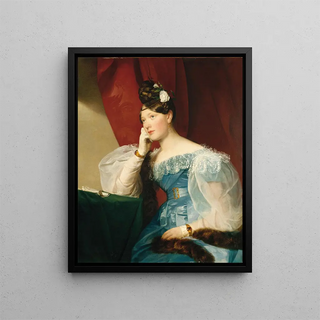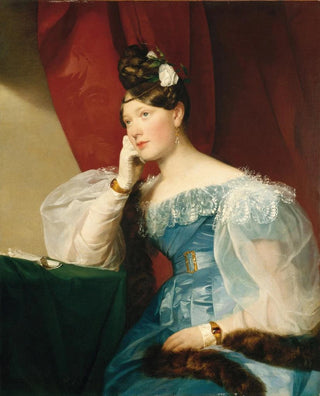Art print | Countess Julie von Woyna - Friedrich von Amerling


View from behind

Frame (optional)
Comtesse Julie von Woyna - Friedrich von Amerling – Captivating Introduction
The painting "Comtesse Julie von Woyna" by Friedrich von Amerling is much more than a simple portrait; it is an open window into an era where elegance and refinement were fundamental values. Created in the 19th century, this artwork embodies the quintessence of Austrian aristocracy, capturing not only the physical beauty of its model but also the very essence of her social status. The graceful pose of the countess, her penetrating gaze, and her sumptuous clothing testify to an unparalleled artistic skill, inviting the viewer to immerse themselves in a universe where every detail is carefully thought out. Contemplating this piece, one immediately feels the subdued atmosphere of salons where prominent figures of society mingled—a world gone but still fascinating.
Style and uniqueness of the work
Friedrich von Amerling's style, renowned for his mastery of portraiture, is distinguished by meticulous attention to detail and a subtle use of light. In "Comtesse Julie von Woyna," the textures of fabrics are rendered with such precision that they seem almost tangible. The nuances of color, ranging from soft tones to brighter highlights, create a harmony that draws the eye and captivates the mind. Amerling manages to combine striking realism with an almost romantic dimension, where the beauty of the countess transcends mere physical appearance to evoke emotional depth. Every element, from the sparkling jewelry to the delicate hairstyle, contributes to the creation of an idealized image, while remaining rooted in the reality of her time. This marriage of realism and idealization is what makes this work so singular and timeless.
The artist and his influence
Friedrich von Amerling, born in 1803 in Vienna, belongs to the lineage of great portraitists of his era. Trained alongside masters of painting, he quickly developed a style that is uniquely his own, blending tradition and innovation. His influence is not limited to his time, as his works continue to inspire many contemporary artists. Amerling was able to capture the spirit of his era, while anticipating the evolutions

Matte finish

View from behind

Frame (optional)
Comtesse Julie von Woyna - Friedrich von Amerling – Captivating Introduction
The painting "Comtesse Julie von Woyna" by Friedrich von Amerling is much more than a simple portrait; it is an open window into an era where elegance and refinement were fundamental values. Created in the 19th century, this artwork embodies the quintessence of Austrian aristocracy, capturing not only the physical beauty of its model but also the very essence of her social status. The graceful pose of the countess, her penetrating gaze, and her sumptuous clothing testify to an unparalleled artistic skill, inviting the viewer to immerse themselves in a universe where every detail is carefully thought out. Contemplating this piece, one immediately feels the subdued atmosphere of salons where prominent figures of society mingled—a world gone but still fascinating.
Style and uniqueness of the work
Friedrich von Amerling's style, renowned for his mastery of portraiture, is distinguished by meticulous attention to detail and a subtle use of light. In "Comtesse Julie von Woyna," the textures of fabrics are rendered with such precision that they seem almost tangible. The nuances of color, ranging from soft tones to brighter highlights, create a harmony that draws the eye and captivates the mind. Amerling manages to combine striking realism with an almost romantic dimension, where the beauty of the countess transcends mere physical appearance to evoke emotional depth. Every element, from the sparkling jewelry to the delicate hairstyle, contributes to the creation of an idealized image, while remaining rooted in the reality of her time. This marriage of realism and idealization is what makes this work so singular and timeless.
The artist and his influence
Friedrich von Amerling, born in 1803 in Vienna, belongs to the lineage of great portraitists of his era. Trained alongside masters of painting, he quickly developed a style that is uniquely his own, blending tradition and innovation. His influence is not limited to his time, as his works continue to inspire many contemporary artists. Amerling was able to capture the spirit of his era, while anticipating the evolutions






